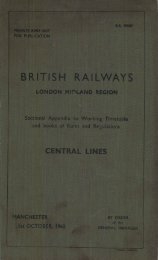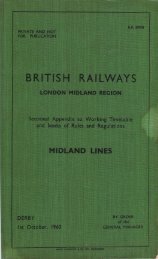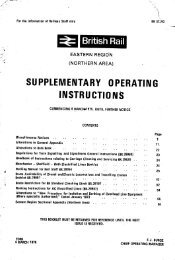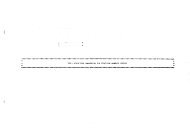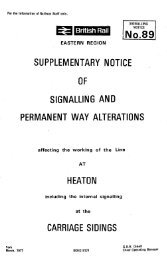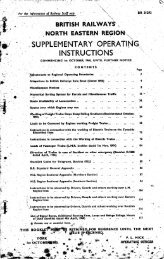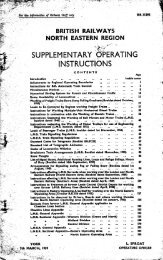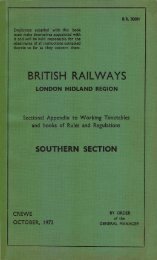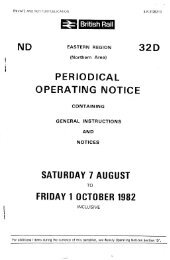general instructions. - Limit Of Shunt
general instructions. - Limit Of Shunt
general instructions. - Limit Of Shunt
You also want an ePaper? Increase the reach of your titles
YUMPU automatically turns print PDFs into web optimized ePapers that Google loves.
Cermrai Enstrintions.—Continued. 1 2 5<br />
Appiiances carrie on trains tor uso ss. cf acciddnt or the emergency<br />
Oirections for their use.—Continued.<br />
It is necessary that the following points be borne in mind<br />
(a) Examine train to see if there are any signs of fire.<br />
(b) Ascertain where the greatest damage has occurred.<br />
(e) Use cushions from the carriages for injured.<br />
(d) Enquire if any can render " First Aid."<br />
(e) Communicate promptly by telegraph, telephone, or. other means,<br />
with the nearest place where doctors, nurses, ambulances and<br />
refreshments are to be. found.<br />
(f) Enlist the services of anyone willing to convey messages or assist<br />
<strong>general</strong>ly under the. direction of the railway staff or- doctors.<br />
(g) Advise the nearest Stationmaster, other officials and permanent<br />
way stall at earliest possible moment.<br />
Extinguishing Fire.<br />
5.—(a) In the event of an Accident happening to a train, any of whose<br />
vehicles are equipped with gas, or<br />
causes, - w h eit rwould e . be t hthe eduty r e of the conductor or guard to endeavour to<br />
obtain<br />
i s<br />
the services of one or more men (passengers if no others are available)<br />
to Act as watchmen and provide them with fire extinguishers.<br />
d a n g e r<br />
o (b) To extinguish f the fire by means of the Liquid Fire Extinguisher,<br />
strike f the i knob r at the e top of the Extinguisher sharply downwards, so as to<br />
break f the r glass oinside. The m Extinguisher will then operate, and it should<br />
be<br />
o<br />
kept in<br />
t<br />
an upright<br />
h<br />
or<br />
e<br />
sloping position when in action.<br />
r<br />
(c) The Tin Bafflers are provided for the purpose of extinguishing gas<br />
flame from a broken pipe. One should be placed smartly between the end<br />
of the.pipe and the yellow flame and then brought quickly<br />
the . opipe v e so r that , t the h pipe e is einside n the d tin, and held there for a short time,<br />
the<br />
o<br />
object<br />
f<br />
of the Baffler is to cut .off the •flame from the point where the gas<br />
is escaping when the pressure is too great to allow of a rug or cushion<br />
being used. If the flame is not extinguished at the first attempt the Baffler<br />
must be again applied. •<br />
(d) The Safety Hand-Lamps are provided for use in the vicinity of<br />
escaping gas. When required for use, press back the catch above the back<br />
handle, turn back the top, and light in the usual way.<br />
(e) Should any gas escaping from gas cylinders or pipes be found to be<br />
alight, the light can <strong>general</strong>ly be extinguished, IF THE PRESSURE OF<br />
THE GAS IS NOT TOO GREAT, by placing a handful of cotton waste,<br />
a carriage rug, cushion or coat between the point of escape and the yellow<br />
flame and pressing it over the hole for a minute to cut off the flame from<br />
the point where the gas is escaping. If the burning gas is escaping at high<br />
pressure from a broken pipe use a Baffler as above directed, or spray the<br />
liquid from a Fire Extinguisher direct into the hole of the pipe, if possible.<br />
If a gas flame is playing on to any woodwork, the woodwork should be kept<br />
wet by -means of a Fire Extinguisher while the Baffler is being used to cut<br />
off the flame. Earth or ballast may be useful for extinguishing burning<br />
woodwork on the ground.




